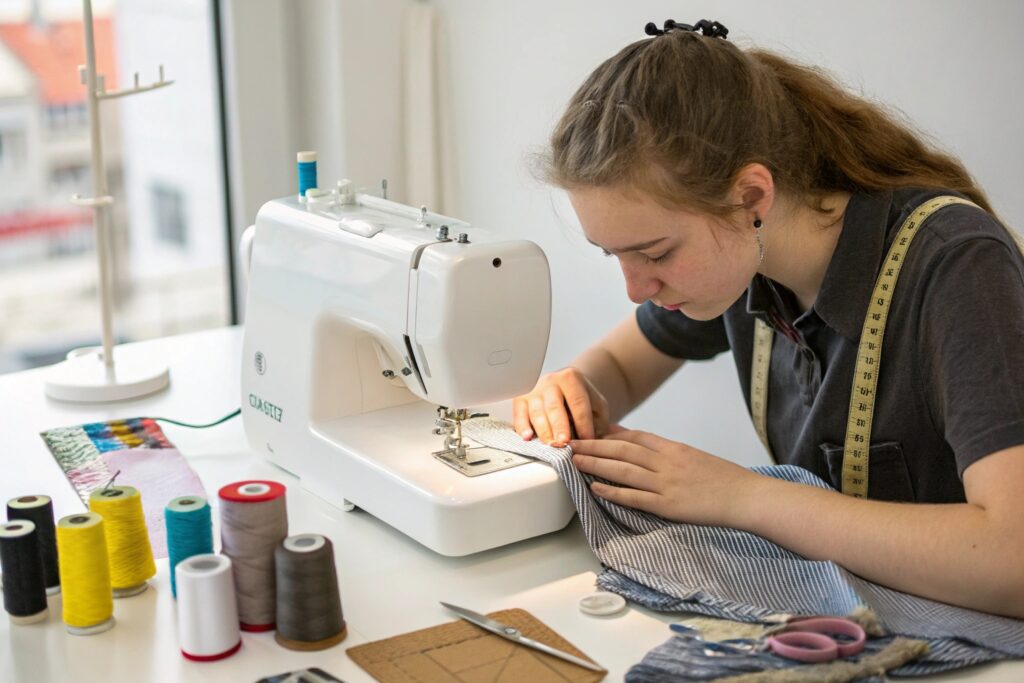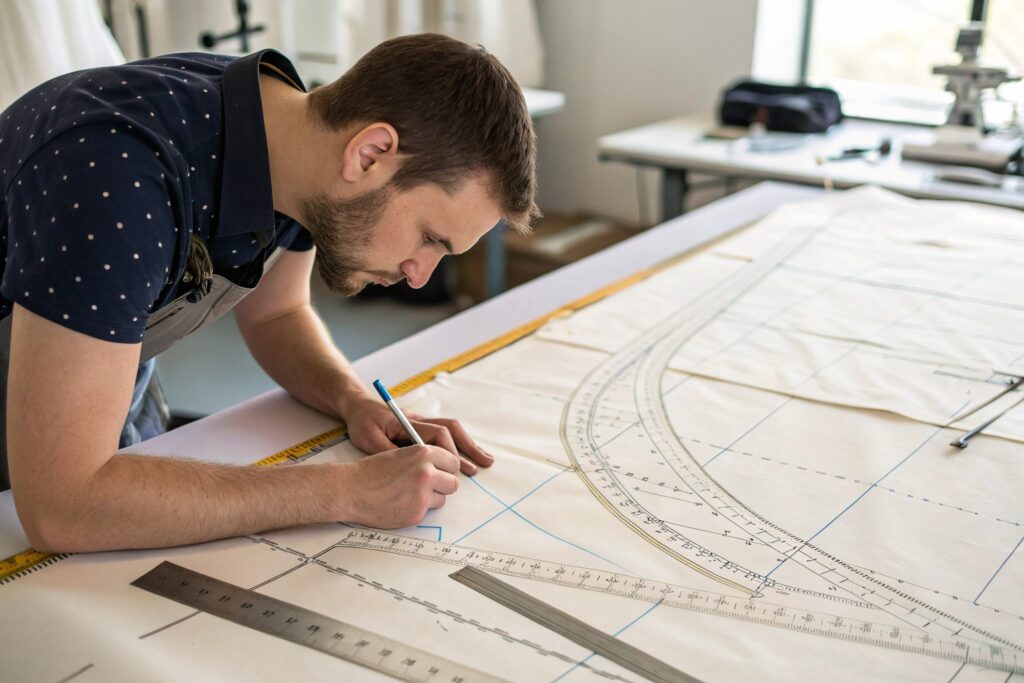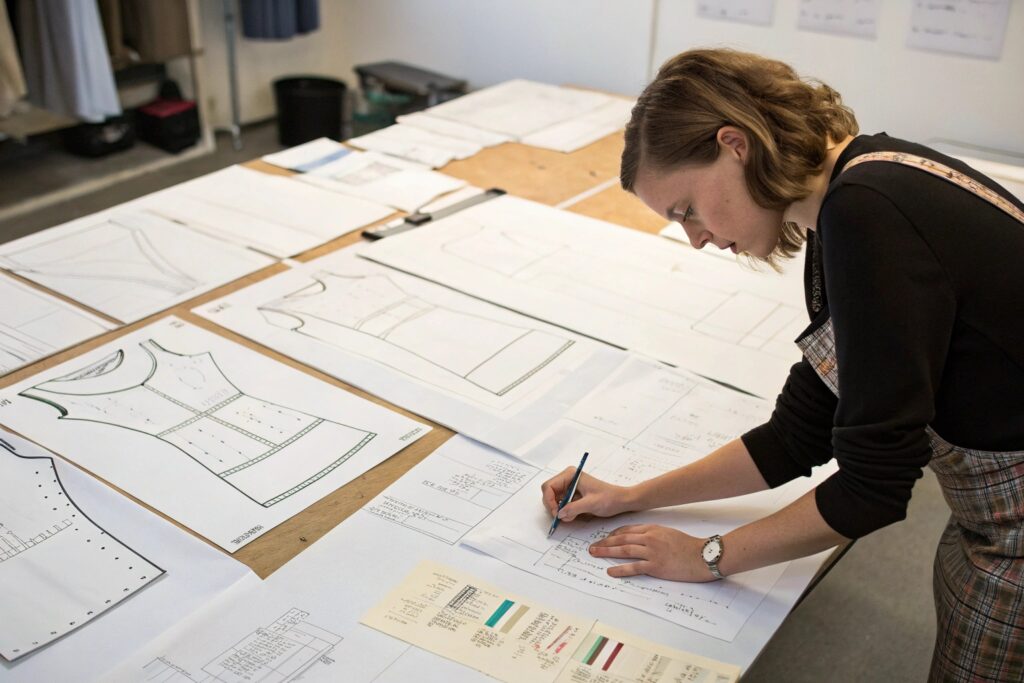If you’re entering the fashion world—whether as a designer, brand owner, or production manager—you’ll eventually ask: should I master sewing, pattern making, or both?
Both sewing and pattern making are essential, but sewing is often the better starting point for beginners, while pattern making becomes more crucial for scaling or designing original garments.
Let’s compare both skills and see what’s better for your goals, career stage, or fashion business model.
Should beginners learn sewing or patterns first?
If you’re new to fashion, it’s tempting to jump into designing—but understanding how clothes are constructed is the foundation.
Beginners should learn sewing first, because it teaches how garments come together, builds hands-on understanding of fit, and prepares you to read or draft patterns more easily.

Why start with sewing?
- Visual + tactile learning – You see how darts, seams, hems work in real time
- Fixing errors – Helps you troubleshoot design mistakes
- Understanding construction – You’ll understand why a sleeve twists, or why fabric pulls
- Empowers prototyping – You can sew samples and test ideas before outsourcing
Once you can sew a basic shirt or dress, learning patterns becomes easier—you already know how fabric behaves.
| Skill Area | Sewing First Benefits | Pattern First Challenges |
|---|---|---|
| Understanding Fit | ✅ Build from body experience | ❌ Only on paper first |
| Fabric Handling | ✅ Real-time learning | ❌ Limited without samples |
| Early Confidence | ✅ Quick visual progress | ❌ Slow feedback loop |
Most students, even in fashion school, start with sewing and basic block manipulation before they dive into drafting custom patterns from scratch.
Is pattern making harder than sewing skills?
Sewing is hands-on. Pattern making is more abstract—and for many, more intimidating at first.
Yes, pattern making is generally harder than sewing because it requires precision, math, spatial awareness, and technical drawing, whereas sewing focuses more on manual skills and machine handling.

What makes pattern making more complex?
- Math and measurements – You must work with fractions, fit curves, and angles
- Flat-to-3D thinking – Visualizing how a 2D pattern turns into a 3D shape
- Error sensitivity – 1 cm off in drafting = major fit problems later
- Grading and sizing – Requires understanding of body proportions, not just shape
That said, pattern making becomes easier if you’ve sewn before. You’ll already know what a seam allowance is, how ease works, and what a bias cut feels like.
Here’s a skill complexity comparison:
| Skill Aspect | Sewing | Pattern Making |
|---|---|---|
| Hands-on Mechanics | ✅ Easier | ❌ Mostly theoretical |
| Math + Drafting | ❌ Minimal | ✅ High |
| Speed of Learning | ✅ Faster | ❌ Slower |
| Room for Experimenting | ✅ High | ❌ Limited |
At Fumao, many of our junior staff learn sewing before assisting with pattern alterations—because real garment experience makes technical drawing more accurate.
Which skill is better for fashion startups?
If you’re building a brand—not working in a factory or atelier—you need both creativity and production understanding.
For fashion startups, pattern making is more valuable long-term, especially if you’re designing your own line, managing tech packs, or working with OEM manufacturers.

Why pattern knowledge supports business better?
-
Custom Design = Competitive Edge
If you can draft or adjust patterns, you don’t rely on templates. -
Faster Tech Pack Communication
You can guide your factory with precision, saving sampling rounds. -
Scalability
Knowing how patterns grade helps you plan size ranges and order efficiently.
But sewing still helps early on:
- Prototype samples in-house
- Test concepts before going to manufacturers
- Control garment quality early
| Role in Startup | Recommended Skill | Why It Helps |
|---|---|---|
| Designer/Founder | ✅ Pattern Making | Speeds product development |
| Product Developer | ✅ Pattern & Sizing Skills | Vital for tech packs |
| Small Batch Maker | ✅ Sewing | Ideal for pre-sale or testing |
| Branding/Marketing | ❌ Not essential | Delegatable |
We’ve worked with startup clients who could design—but lacked pattern knowledge—so they depended heavily on sample correction. Those with basic pattern skills saved thousands in revisions.
Do designers need sewing or pattern skills more?
Not all fashion designers sew. Not all pattern makers design. So which matters more?
Designers benefit more from pattern skills than sewing, because understanding how garments are shaped and constructed enables better communication, innovation, and scalability.

Why pattern literacy matters for design?
- Improves design practicality – You’ll avoid styles that can’t be built
- Enables creative exploration – You can manipulate silhouettes freely
- Reduces dependency on sample makers – You know how the garment should fit
- Strengthens collaboration with factories – Pattern-ready sketches are production-ready faster
Sewing is still useful—for:
- Mockups and muslins
- Quality control
- Fixing or adjusting samples manually
But as a designer grows in their career or brand, pattern fluency becomes more strategic.
| Role | Sewing Needed | Pattern Skills Needed |
|---|---|---|
| Fashion Designer | ✅ Basic | ✅✅ Essential |
| Technical Designer | ❌ Rarely | ✅✅✅ Must-have |
| In-House Sample Maker | ✅✅✅ Must-have | ✅ Helpful |
| Factory Liaison/Founder | ✅ Helpful | ✅✅ Essential |
At Fumao, designers who submit clear sketches with accurate pattern intent always get better samples on the first try—because we understand exactly what they want.
Conclusion
Sewing gives you hands-on control and speed early on. Pattern making gives you creative freedom and technical power as you grow. For beginners: start with sewing. For brand owners or designers: invest in pattern skills—they’ll pay off every season.










